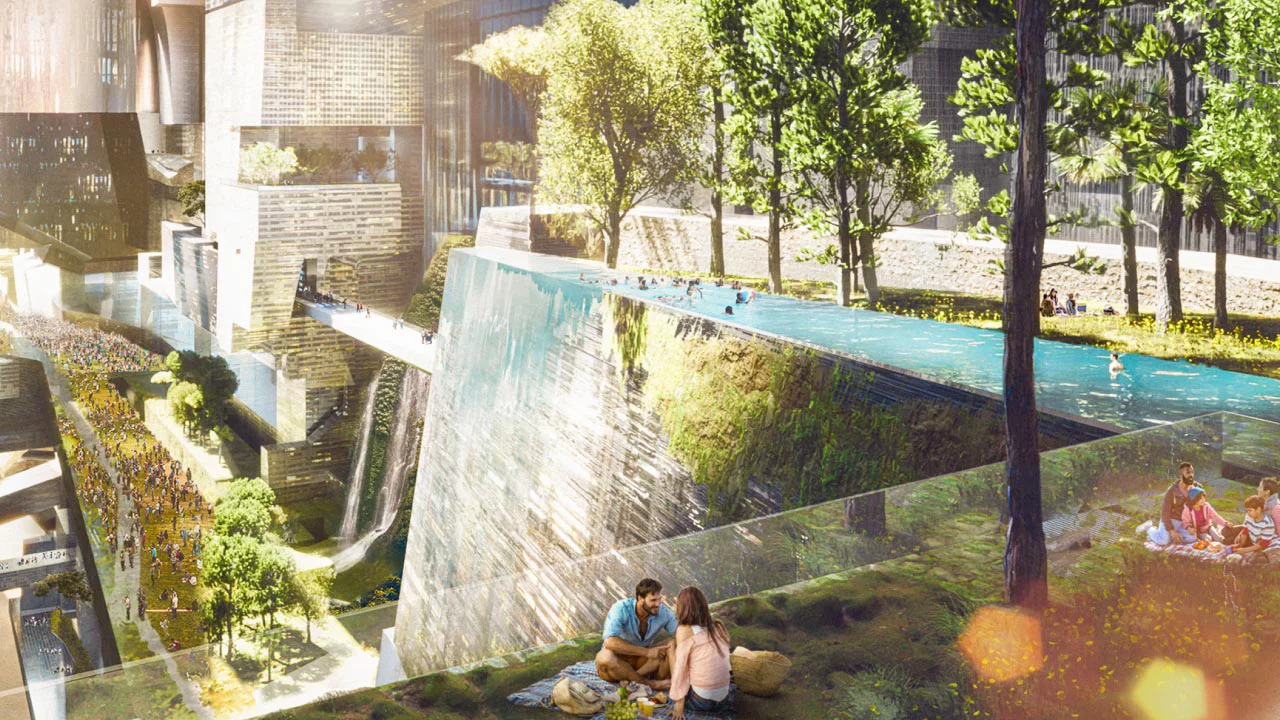In the heart of Saudi Arabia’s vast desert, where nothing but sand and mountains stretch for miles, a revolutionary project is taking shape NEOM. Marketed as a city of the future, this ambitious mega-project is the brainchild of Crown Prince Mohammed bin Salman, envisioned as a hub of innovation, sustainability, and cutting-edge technology. Spanning over 26,500 square kilometers, NEOM is set to redefine urban living with its futuristic designs, AI-driven infrastructure, and promises of a carbon-neutral environment.
From The Line a 170-kilometer-long linear city with no roads or cars to Oxagon, the world’s largest floating industrial complex, and Trojena, a year round mountain resort offering skiing in the desert, the scope of NEOM is staggering. The project aims to attract the world’s brightest minds and position Saudi Arabia as a leader in tech, renewable energy, and tourism.
Billions of dollars have been poured into the project, with Saudi officials claiming it will become a beacon of progress and a model for future cities. However, skepticism looms large. Critics argue that NEOM’s promises are too ambitious, questioning whether the city can truly deliver on its futuristic vision or if it will become yet another extravagant but ultimately unfulfilled dream.
With all the grand promises, one question lingers: is NEOM truly the city of tomorrow, or just a high-budget illusion?

NEOM’s Vision: Ambition Without Limits
First announced in 2017, NEOM is projected to cover a staggering 26,500 square kilometers, making it one of the largest smart city projects in the world. The vision is bold an ultra-modern metropolis powered entirely by renewable energy, free of cars and pollution, and driven by artificial intelligence in every aspect of life.
At the heart of NEOM lies Saudi Arabia’s Vision 2030, a strategic framework to reduce the kingdom’s dependence on oil, diversify its economy, and develop public service sectors. With an estimated budget exceeding $500 billion, NEOM represents the crown jewel of this transformation plan, designed to showcase Saudi Arabia’s ambition to become a global innovation leader.
The Line: Vertical Urban Living Reimagined
The Line is perhaps NEOM’s most audacious component a 170-kilometer-long linear city designed to eventually house 9 million residents within a footprint of just 34 square kilometers. Unlike traditional cities that expand outward, The Line extends vertically, with a planned height of 500 meters and width of 200 meters.

Recent construction updates from April 2025 show significant progress, with concrete foundation works underway at multiple sections. Satellite imagery reveals extensive excavation and the beginnings of the massive mirrored exterior that will define The Line’s futuristic aesthetic.
The concept eliminates traditional transportation infrastructure, with residents able to access all daily needs within a five-minute walk. A high-speed rail system running the length of the structure promises to transport people from one end to the other in just 20 minutes.
“Imagine then a whole city within a 500-meter tall and 200 meter-wide building, stretching 170 kilometers across the coast, desert and mountains of Northeast Saudi Arabia. A place housing nine million people within 34 square kilometers. Well, that’s what we are building with THE LINE, the ultimate sidescraper.”
by Giles Pendleton
Chief Operating Officer
The Line A revolution in urban living
Oxagon: Reimagining Industrial Development
Oxagon represents another revolutionary component of NEOM—the world’s largest floating industrial complex. This octagon-shaped city extends from the shore into the Red Sea, covering 48 square kilometers. Designed to become a hub for advanced and clean industries, Oxagon aims to pioneer a new approach to manufacturing that harmonizes with nature rather than exploiting it.

The industrial city will focus on seven sectors: sustainable energy, autonomous mobility, water innovation, sustainable food production, health and well-being, modern construction, and digital manufacturing. With a planned port capacity of 1.5 million TEU (Twenty-foot Equivalent Units), Oxagon is positioned to become a major logistics hub connecting Asia, Europe, and Africa.
Oxagon: A Reimagined Industrial City in NEOM
Trojena: Alpine Living in the Desert
Perhaps the most surreal aspect of NEOM is Trojena, a mountain destination located in the Sarwat Mountains where winter temperatures drop below freezing. This planned year-round tourist destination will feature the first outdoor ski resort in the Gulf region, despite being situated in one of the world’s hottest countries.

Located at altitudes up to 2,600 meters above sea level on Jebel al Lawz mountain, Trojena will offer a stark contrast to Saudi Arabia’s typical desert landscape. The project includes plans for luxury hotels, an artificial freshwater lake, and adventure sports facilities. Construction began in 2022, with the first phase expected to be completed by 2026 to align with Saudi Arabia’s bid to host the 2030 Asian Winter Games.
Trojena – A year-round mountain destination
The Technological Ambitions: Beyond Science Fiction
NEOM’s technological vision extends far beyond conventional smart cities. The project aims to integrate cutting-edge innovations across every aspect of urban life:
AI Governance and Digital Twin
NEOM plans to implement an AI-driven governance system that will manage everything from traffic flow to energy distribution. A comprehensive digital twin—a virtual replica of the entire city—will enable real-time monitoring and predictive maintenance of infrastructure.
The city will collect vast amounts of data through millions of IoT sensors, cameras, and connected devices. This data will feed into centralized systems designed to optimize resource allocation, predict maintenance needs, and enhance security. However, this level of surveillance raises significant privacy concerns that remain largely unaddressed in public communications.
Renewable Energy Innovation
Energy sustainability forms a cornerstone of NEOM’s vision, with plans to power the city entirely through renewable sources. The project has announced a $5 billion green hydrogen plant—the world’s largest—to be operational by 2026. This facility aims to produce 650 tons of carbon-free hydrogen daily, using electrolysis powered by solar and wind energy.
The hydrogen will serve both as an export commodity and as fuel for NEOM’s transportation systems and industrial processes. This ambitious energy plan faces significant technical challenges, particularly in scaling hydrogen production to the levels required for a city of NEOM’s size.
Vertical Farming and Food Innovation
To address food security in the harsh desert environment, NEOM is investing heavily in vertical farming and agricultural technology. These systems promise to use 95% less water than conventional farming while producing higher yields in controlled environments.
The city plans to integrate these farms directly into residential areas of The Line, creating ultra-local food production that eliminates transportation emissions and provides residents with fresh produce year-round.
The Challenges: Bold Vision or Unrealistic Dream?
Despite the hype, NEOM faces several critical obstacles that could derail its ambitious vision:
Geographical and Climate Challenges
Building a high-tech city in an arid desert with extreme temperatures presents formidable challenges. Water scarcity is particularly acute, with Saudi Arabia already relying heavily on energy-intensive desalination. NEOM plans to address this through advanced desalination plants powered by renewable energy, but the scale required is unprecedented.
Recent environmental impact assessments have raised concerns about potential climate disruption. In May 2025, Donald Wuebbles, a climate advisor to NEOM, warned that the massive scale of The Line could alter local weather patterns by creating wind tunnels and heat islands. These effects could potentially undermine the project’s sustainability goals.
Technological and Infrastructure Gaps
Many of the technologies NEOM promises either don’t exist at scale or haven’t been proven in real-world conditions. The engineering challenges of constructing a 500-meter-tall, 170-kilometer-long mirrored structure are unprecedented. Recent construction updates show progress on foundation work, but experts question whether the full vision of The Line is technically feasible within the projected timeframe.
The appointment of Aiman Al-Mudaifer as NEOM’s new CEO in May 2025 signals recognition of these challenges. Al-Mudaifer’s background in infrastructure development suggests a shift toward more practical implementation strategies after years of futuristic marketing.
Financial Uncertainty and Timeline Revisions
While Saudi Arabia has pledged billions to NEOM, securing sufficient foreign investment remains challenging. The project’s initial completion date of 2030 has been quietly extended, with recent reports suggesting The Line might not be fully realized until 2045 or later. Some analysts project that complete implementation could stretch to 2080, raising questions about the project’s long-term viability.
Cost overruns have already emerged as a significant concern. The initial 500billion budget now appears insufficient, with some estimate ssuggesting the final cost could exceed 500 billion budget, This financial pressure comes at a time when Saudi Arabia is still working to diversify its economy away from oil dependence.
Human Rights and Social Concerns
The development of NEOM has raised serious human rights concerns, particularly regarding the displacement of local Huwaitat tribe members from their ancestral lands. Human rights organizations have documented forced evictions and resistance to these displacements, including reports of violence and imprisonment of those who refused to relocate.
These issues have complicated NEOM’s efforts to attract international partners and talent. Several high-profile advisors and potential investors have distanced themselves from the project following negative publicity around these human rights concerns.
Global Reactions: Enthusiasm or Skepticism?
The international response to NEOM has been mixed. Some see it as a bold step toward the future, while others doubt its practicality. Tech giants like Google, Microsoft, and Amazon have expressed interest, yet major investments are still pending.
Urban planning experts remain divided. Some praise NEOM’s ambition to reimagine city design for sustainability, while others criticize it as a top-down approach that ignores the organic development that makes cities vibrant and livable.
Environmentalists have raised concerns about the ecological impact of such massive construction in sensitive desert and coastal ecosystems. While NEOM promises environmental sustainability, the sheer scale of the project inevitably involves significant disruption to natural habitats.
NEOM: A Revolution or a Mirage?
If NEOM succeeds as envisioned, it will redefine urban living and cement Saudi Arabia’s place as a leader in futuristic development. The project could demonstrate new approaches to sustainability, transportation, and resource management that might influence city planning worldwide.
However, if it fails to deliver, it risks becoming another overhyped mega-project that never reaches its full potential. The history of planned cities suggests that those designed from scratch often struggle to develop the cultural vibrancy and economic dynamism of organically grown urban centers.
The reality will likely fall somewhere between these extremes. Parts of NEOM particularly Oxagon and Trojena may prove more feasible than the full vision of The Line. The project may evolve significantly from its initial concept as it confronts technical, financial, and social realities.
What’s certain is that NEOM represents one of the most ambitious attempts to reimagine urban living in human history. Whether it becomes a model for future cities or a cautionary tale of overreach will depend on how effectively it can translate its visionary concepts into practical reality while addressing the legitimate concerns about its implementation.
Only time will tell whether NEOM is a true revolution or just a mirage in the desert.
Frequently Asked Questions
What is the current construction status of NEOM and The Line?
As of mid-2025, construction on NEOM is actively underway, though at varying stages across different components. Recent satellite imagery and construction updates from April 2025 show significant progress on The Line, with concrete foundation works visible at multiple sections along the planned 170-kilometer route. Excavation work and initial structural elements are taking shape, particularly in the coastal areas.
Oxagon has seen development of its port facilities and initial industrial zones, while Trojena has begun infrastructure development for its planned ski resort and tourism facilities. However, the overall project is proceeding more slowly than initially projected. The original timeline aimed for substantial completion by 2030, but current estimates suggest The Line might not be fully realized until 2045 or later, with some analysts projecting completion could extend to 2080.
The first residential sections of The Line are now expected to be habitable by 2028, significantly later than original projections. NEOM officials have begun describing the project as a multi-generational endeavor rather than a near-term development.
How will NEOM address water scarcity in the desert environment?
NEOM plans to address water scarcity through a multi-faceted approach centered on advanced desalination technology. The project is developing what it claims will be the world’s largest and most energy-efficient desalination facilities, powered entirely by renewable energy to minimize the carbon footprint typically associated with desalination.
The water management strategy includes:
1.Solar-powered desalination plants that will convert Red Sea water into fresh water
2.Atmospheric water generation technology that extracts moisture from the air
3.Comprehensive water recycling systems that will treat and reuse nearly 100% of wastewater
4.Smart water distribution networks that minimize leakage and optimize usage
5.Advanced irrigation techniques for landscaping and agriculture that reduce water consumption by up to 95% compared to conventional methods
However, environmental experts have raised concerns about the brine discharge from desalination plants and its potential impact on Red Sea marine ecosystems. NEOM claims its advanced desalination technology will address these concerns through more environmentally friendly brine management, though specific technical details remain limited.
What are the environmental impacts and sustainability features of NEOM?
NEOM presents itself as a model of environmental sustainability, with plans for 100% renewable energy, zero-emission transportation, and circular economy principles. Key sustainability features include:
1.A 650-ton per day green hydrogen production facility to provide clean energy
2.Vertical farming and food technology to reduce agricultural land and water use
3.A car-free environment in The Line to eliminate transportation emissions
4.Building designs that maximize natural lighting and passive cooling
5.Extensive use of sustainable building materials and construction methods
However, the environmental impacts of construction itself are significant. The massive scale of development involves extensive land clearing, excavation, and resource consumption. Recent environmental assessments have raised concerns about potential climate disruption, with NEOM’s own climate advisor warning in May 2025 that The Line could alter local weather patterns by creating wind tunnels and heat islands.
Additionally, the project’s location includes sensitive desert and coastal ecosystems. While NEOM has promised to protect and enhance biodiversity, the transformation of natural landscapes on this scale inevitably disrupts existing habitats. Environmental organizations have called for more transparent and comprehensive environmental impact assessments.
How does NEOM compare to other planned cities and mega-projects globally?
NEOM stands out from other planned cities and mega-projects in several ways:
1.Scale and Ambition: At 26,500 square kilometers, NEOM is significantly larger than most planned cities. For comparison, South Korea’s Songdo International Business District covers just 6 square kilometers, while China’s Xiong’an New Area spans 2,000 square kilometers.
2.Financial Investment: With an estimated budget exceeding 500billion, NEOM represents one of the largest single investments in urban development in history, dwarfing projects like Malaysia’s Forest City (100 billion) or Egypt’s New Administrative Capital ($58 billion).
3.Architectural Innovation: The Line’s linear city concept with its 500-meter height and 170-kilometer length has no direct precedent. Most planned cities follow more conventional urban layouts, even when incorporating smart technology.
4.Technological Integration: While other smart cities like Singapore and Toronto’s Quayside focus on specific technological applications, NEOM aims for comprehensive integration of AI, robotics, and IoT across all aspects of urban life.
5.Timeline and Implementation: NEOM’s multi-decade implementation timeline is longer than most urban development projects, reflecting both its ambition and the challenges it faces.
The project that perhaps comes closest to NEOM in vision is China’s Xiong’an New Area, which also aims to be a model for innovative urban development. However, even Xiong’an follows a more conventional urban form and focuses more on economic development than technological revolution.
What economic opportunities and challenges does NEOM present for Saudi Arabia?
NEOM presents significant economic opportunities for Saudi Arabia, primarily as a vehicle for economic diversification beyond oil. The project aims to create new industries in technology, tourism, biotechnology, media, and clean energy that could generate substantial non-oil revenue and create high-skilled jobs for Saudi citizens.
Specific economic opportunities include:
1.Developing a green hydrogen export industry through NEOM’s planned production facilities
2.Establishing Saudi Arabia as a tourism destination through Trojena’s mountain resort
3.Creating a technology and innovation ecosystem that could attract global companies
4.Developing expertise in sustainable construction and smart city technologies that could be exported globally
5.Enhancing Saudi Arabia’s global soft power and investment attractiveness
However, the project also presents substantial economic challenges:
1.The massive capital requirements strain Saudi finances, especially if oil prices fluctuate
2.The risk of creating a “white elephant” if the project fails to attract sufficient residents and businesses
3.Uncertainty about the return on investment timeline, with profits potentially decades away
4.Challenges in developing the human capital needed to operate and maintain such advanced systems
5.Potential opportunity costs of concentrating so much investment in a single mega-project rather than distributing it across existing urban centers
The success of NEOM as an economic catalyst will depend largely on its ability to attract international businesses, investors, and talent—a goal complicated by both the project’s remote location and Saudi Arabia’s social and political environment.





